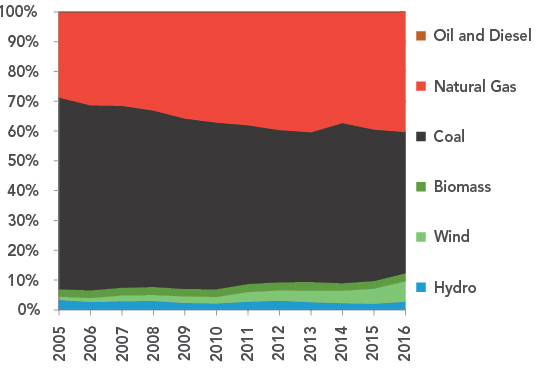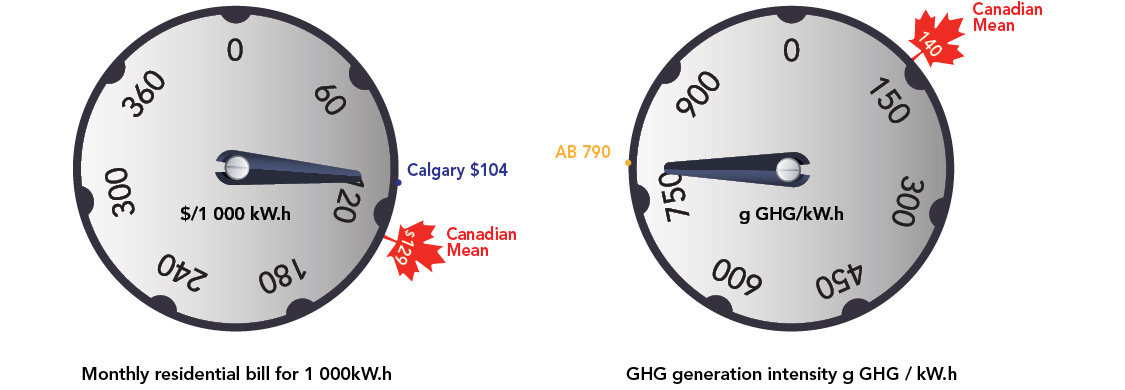ARCHIVED – Canada’s Renewable Power Landscape 2017 – Energy Market Analysis
This page has been archived on the Web
Information identified as archived is provided for reference, research or recordkeeping purposes. It is not subject to the Government of Canada Web Standards and has not been altered or updated since it was archived. Please contact us to request a format other than those available.

Alberta
In 2016, Alberta generated 47.4% of its electricity from coal, 40.3% from natural gas, and 12.3% from renewables. Wind was the largest source of renewable power, generating 6.9% of Alberta’s electricity.
FIGURE 9 Electricity Generation by Source in Alberta

Description
This graph shows the composition of Alberta’s electricity generation between 2005 and 2016. Hydro accounted for 3.4% of generation in 2005 and 2.8% in 2016. Biomass increased from 2.5% to 2.7% over that period. Wind increased from 1.1% in 2005 to 6.9% in 2016. Coal decreased from 64.3% to 47.4%. Natural gas, increased its share from 28.7% to 40.3%.
TABLE 3 Electric Capacity and Generation in Alberta
| Capacity in MW and % | Generation in GW.h and % | |||||
|---|---|---|---|---|---|---|
| 2005 | 2015 | 2016 | 2005 | 2015 | 2016 | |
| Oil and Diesel | 7 | 7 | 7 | 17 | 12 | 0 |
| 0.1% | <0.1% | <0.1% | <0.1% | <0.1% | 0.0% | |
| Natural Gas | 4 770 | 7 214 | 7 519 | 19 657 | 32 215 | 33 184 |
| 39.7% | 44.3% | 45.3% | 28.7% | 39.5% | 40.3% | |
| Coal | 5 840 | 6 287 | 6 287 | 43 986 | 41 378 | 39 000 |
| 48.6% | 38.6% | 37.9% | 64.3% | 50.7% | 47.4% | |
| Biomass | 271 | 428 | 428 | 1 725 | 2 149 | 2 201 |
| 2.3% | 2.6% | 2.6% | 2.5% | 2.6% | 2.7% | |
| Wind | 251 | 1 463 | 1 467 | 741 | 4 089 | 5 674 |
| 2.1% | 9.0% | 8.8% | 1.1% | 5.0% | 6.9% | |
| Hydro | 869 | 894 | 894 | 2 316 | 1 709 | 2 282 |
| 7.2% | 5.5% | 5.4% | 3.4% | 2.1% | 2.8% | |
| All renewable sources | 1 391 | 2 785 | 2 789 | 4 782 | 7 947 | 10 156 |
| 11.6% | 17.1% | 16.8% | 7.0% | 9.7% | 12.3% | |
| All sources | 12 008 | 16 293 | 16 602 | 68 442 | 81 552 | 82 341 |
Generation Trends
Electricity generation in Alberta is dominated by coal and natural gas. Since 2005, generation has trended towards less coal and more natural gas, and this trend is set to continue as Alberta plans to phase out coal by 2030. Currently, coal generates 47.4% of Alberta’s electricity.
Wind generation has added more capacity than any other renewable source in Alberta. Since 2005, wind’s share of total generation increased from 1.1% to 6.9%. Alberta now has the third highest wind generation in Canada (5 674 GW.h in 2016) after Quebec and Ontario. Most Alberta wind farms are located in the windy southern part of the province.
Biomass and hydro generation have been steady in Alberta. The share of generation for each of these sources fluctuated between 2% and 3% in recent years.
Capacity Changes in 2016
Alberta added an estimated 305 MW of natural gas-fired generation in 2016. Most of this was cogeneration of electricity and steam for oil sands production. The largest addition was the 100 MW Christina Lake cogeneration facility. Electricity from this facility is sold on Alberta’s wholesale electricity market while its steam is used for in-situ oil sands production.
The Cowley Ridge wind facility was Canada’s first commercial wind farm. TransAlta retired it in 2016 after 23 years in service. Despite this, Alberta increased wind capacity mainly due to expansions at the Bull Creek Wind Facility.
More Information
Canada’s Renewable Power Landscape 2016 – Energy Market Analysis provides additional information on renewable power in Alberta.
Residential Bills and Greenhouse Gas Generation Intensity
Alberta’s most populous city, Calgary, has a relatively low residential electricity bill of $104 for 1 000 kW.h compared to the Canadian mean of $129 per 1 000 kW.h. Alberta’s GHG generation intensity is the highest in Canada, emitting 790 grams of GHGs per kW.h which is nearly six times Canada’s mean of 140 g GHG/kW.h.
FIGURE 10

Source and Description
Source:
Hydro-Québec, National Inventory Report
Description:
Two dials indicate the monthly residential electricity bill for 1 000 kW.h and the GHG generation intensity in grams of GHG per kW.h. Alberta’s most populous city, Calgary, has a relatively low residential electricity bill of $104 for 1 000 kW.h compared to the Canadian mean of $129 per 1 000 kW.h. Alberta’s GHG generation intensity is the highest in Canada, emitting 790 grams of GHGs per kW.h which is nearly six times Canada’s mean of 140 g GHG/kW.h.
- Date modified:
